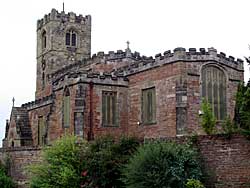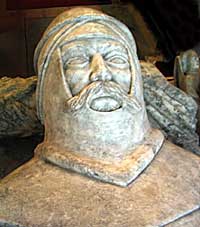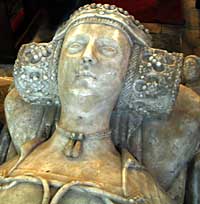Strelley

All Saints' church, Strelley. The chancel was built by Sampson de Strelley in the 1350s (photo: A Nicholson, 2005).
The name of Strelley, sometimes found as Sterley, used to be popularly derived from "stella", a star, and the star devices on some of the old tombs in this church are supposed to refer to this. Unfortunately this theory is discredited by modern etymologists, who attach more importance to the other spellings, "Stredlegh" and "Stretley", commonly found in the Middle Ages. In the "Place-names of Nottinghamshire", recently published by the English Place-names Society, the name is said to be clearly a compound of the Old English "Straet" and "leah", meaning clearing, although, say the editors, no Roman road (such as "street" uaually signifies) is known to have existed in the neighbourhood. They were probably unaware that in 1937 members of this Society discovered a Roman camp at Broxtowe, a very short distance from Strelley. This certainly supports their definition, for where the Romans made camps, they made roads to and from them.
According to Thoroton, there were originally three manors in Strelley. At the time of Domesday Book two, which were of Peverel's fee, were held by. Godwin the priest and Ambrose, the pre-Conquest owners having been Godric and Brun; the third, part of the land of the thanes, belonged to Ulsy and Godwin (formerly to Ulchel). Nothing more is known of the owners until the reign of Henry I (1100-1135), when Walter de Stradlegh, or Strelley, married Isilia , widow of William de Moiz. Here begins our knowledge of the family who held Strelley until the latter part of the seventeenth century, and a branch of whom still lived, until very recently, at Oakerthorpe in Derbyshire. They proudly boasted that twelve generations were honoured by knighthood, and their long pedigree was printed in the Journal of the Derbyshire Archaeological and Natural History Society in 1892. Strelley, like Clifton and a few others, is one of the family names constantly recurring in local documents of the Middle Ages, and although the family played no great part in national history, they were constantly active in local affairs, representing the county in Parliament as knights of the shire, leading levies against the Scots, and so on.
Walter and Isilia had a son named Sampson, who supported John's rebellion against his brother Richard I (John was popular in Nottinghamshire), with the result that Strelley was seized by the King, and only restored on payment of a fine. But Sampson was handsomely recompensed when John came to the throne in 1199.
His son Walter married Cecilia, daughter and co-heiress of Robert de Sumervill of Oxton, so bringing in the Oxton property, and their son Robert (died 1284), was taken prisoner at Kenilworth while fighting for the rebel Simon de Montfort in 1265. The next owner, Robert II (1254-1302), acquired the manor of Bilborough by his marriage with Elizabeth, daughter of Sir Robert Vavasour. According to his inquisition post mortem, made in 1302, he held the manor and the advowson of the church of Strelley, with a capital messuage (presumably the old Hall) worth 10/- yearly, "as in fruit of the garden, herbage and dovecot". (This should, of course, be multiplied by thirty or forty to get some idea of its equivalent modern value). A park and a windmill are mentioned, and he also possessed land and a windmill in Ghilwell, and the manor and advowson of Bilborough.
The Strelleys of Woodborough traced their descent from Robert's brother Sampson, who was a verderer of Sherwood Forest in 1509.

Sampson de Strelley died in 1390 (photo: A Nicholson, 2005).
Again a Robert succeeded (this constant repetition of Christian names is one of the bugbears of students of mediaeval history), and he was the father of the most notable Sampson de Strelley. Sampson was the rebuilder of the church, according to Thoroton, who wrote that in 1356, he "had licence that he and the rest of the parishioners of that village, might hear sermons for the space of a year in the Chappel scituate within the Manner of the said village, because the Parish church was not then fully built". The lower stage of the tower is all that remains of the earlier church.
Sampson is believed to be commemorated by the splendid altar tomb in the centre of the chancel. The identification has been doubted, because he was thought to have died about 1390, while the costumes and armour are thought by experts to be more characteristic of the period between 1405 and 1410; but, as a matter of fact, a reference to Sampson in the Cartulary of Newstead Priory that is now in the Nottingham Public Libraries shows that he was apparently still alive in 1393, so that his death may have been a good deal later than was believed*. (Sampson was evidently a somewhat highhanded individual, as the note in the Cartulary refers to his having seized lands in Cossall to which he had no right, and having calmly moved a road some distance from its original position, and claimed that it belonged to Strelley instead of to Cossall.) To return to the question of the tomb: there is also the possibility that it was not erected until the death of Sampson's wife Elizabeth, daughter of Sir John Hercy, and reflects the fashion of that time. But it is equally likely that it really is in memory of Sampson's son, Nicholas, who died in 1430, and by his will, now at York, directed that his body should be buried at Strelley, and left money for the usual services for the repose of his soul. On the other hand, two graves discovered during alterations, one on each side of the altar, may be those of Nicholas and his wife, Elizabeth, daughter of Sir Edmund Pierpont. The tomb has no date or inscription, so that the question cannot be settled definitely.

Sampson de Strelley's wife, Elizabeth, died in 1405 (photo: A Nicholson, 2005).
The incised floor-stone at the north-west corner of the altar-tomb commemorates Nicholas's son, Robert, who died in 1438 (the date and the rest of the inscription are now illegible). He was a lancer at Agincourt in 1415, in the retinue* of Lord Grey of Codnor. On the south side of Sir Sampson's tomb is the slab of Robert's brother John, who died in 1421, but he had little connection with Strelley. At the west end is the brass of Robert's son, yet another Robert, who died in 1487/8. His wife Isabel, sister of Cardinal Archbishop Kemp, died at Oxton in 1458/9; her brass shows a beautiful example of the butterfly style of headdress.
